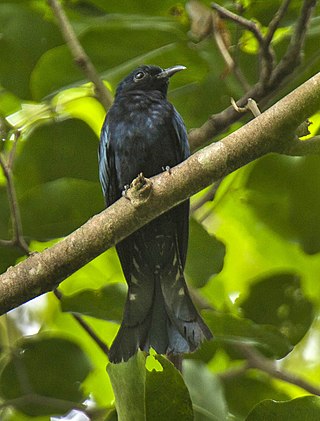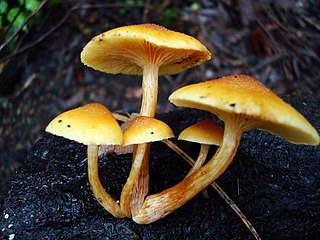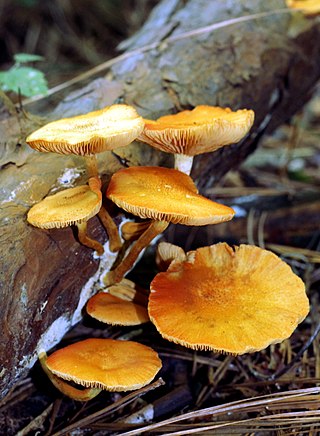
The dwarf fat-tailed mouse opossum, also known as the velvety fat-tailed opossum is an opossum species from South America. It is endemic to Brazil, where it is found in cerrado and caatinga habitats. Its head-and-body length is about 141-212 mm, and its tail length is about 73-85 mm. Its diet is 44% arthropods; 75% of its diet consists of animals and animal products. Its ventral fur is entirely gray-based. Its hind foot is less than 14 mm, which is short for the genus.

Gymnopilus junonius is a type of mushroom-forming fungus in the family Hymenogastraceae. Commonly known as the spectacular rustgill, this large orange mushroom is typically found growing on tree stumps, logs, or tree bases. Some subspecies of this mushroom contain the neurotoxic oligoisoprenoid gymnopilin.

Gymnopilus is a genus of gilled mushrooms within the fungal family Hymenogastraceae containing over 200 rusty-orange spored mushroom species.

Gymnopilus luteofolius, known as the yellow-gilled gymnopilus, is a large and widely distributed mushroom that grows in dense clusters on dead hardwoods and conifers. It grows in late July to November in the east and in the winter on the west coast of North America. It has a rusty orange spore print and a bitter taste.

Pachnodus velutinus was a species of air-breathing land snail, a terrestrial pulmonate gastropod mollusk in the family Cerastidae. This species was endemic to the Seychelles. It is now extinct.

The Philippine drongo-cuckoo is a bird of the cuckoo family found only in the Philippines. It belongs to the genus Surniculus along with the Asian drongo-cuckoo. The two were previously classified as a single species but are now often separated based on differences in calls and juvenile plumage.

Gymnopilus aeruginosus, also known as the magic blue gym, is a mushroom-forming fungus that grows in clusters on dead wood and wood chip mulch. It is widely distributed and common in the Pacific Northwest. It has a rusty orange spore print and a bitter taste and contains the psychedelic chemical psilocybin. It was given its current name by mycologist Rolf Singer in 1951.

Gymnopilus purpuratus is a species of agaric fungus in the family Hymenogastraceae. It grows in clusters on dead wood, tree stumps and wood chip mulch. It is widely distributed and has been recorded in Argentina, Australia, Chile, New Zealand, the UK and Germany. It has a broadly convex cap covered in small dry reddish-brown scales, a stout yellow stem beneath reddish brown, wine-red to purple vertical fibres, and a thick rusty orange spore print.

Gymnopilus sapineus, commonly known as the scaly rustgill or common and boring gymnopilus, is a small and widely distributed mushroom which grows in dense clusters on dead conifer wood. It has a rusty orange spore print and a bitter taste. This species does not stain blue and lacks the hallucinogen psilocybin.

Gymnopilus liquiritiae is a mushroom in the family Hymenogastraceae. The mushroom is widely distributed and grows in dense clusters on dead conifer wood. It has a rusty orange spore print, a bitter taste, and does not contain the hallucinogen psilocybin. One of its key distinguishing features is the lack of partial veil.
Gymnopilus luteus, known as the yellow gymnopilus, is a widely distributed mushroom-forming fungus of the Eastern United States. It contains the hallucinogens psilocybin and psilocin. It is often mistaken for G. speciosissimus and G. subspectabilis.

Gymnopilus viridans is a mushroom in the family Hymenogastraceae. It contains the hallucinogens psilocybin and psilocin. It is a rarely documented species, the last known collection being from the US state of Washington in 1912.

Gymnopilus validipes is a mushroom in the family Hymenogastraceae. It is widely distributed in North America and Europe.

Gymnopilus luteoviridis is a widely distributed mushroom-forming fungus of the Eastern United States that contains the hallucinogens psilocybin and psilocin.

Gymnopilus braendlei is a species of agaric fungus in the family Hymenogastraceae that contains the hallucinogens psilocybin and psilocin. It was originally described by mycologist Charles Horton Peck as Flammula braendlei, from specimens found in the District of Columbia in 1902.

Ceanothus velutinus, with the common names snowbrush ceanothus, red root, tobacco brush, and sticky laurel, is a species of shrub in the family Rhamnaceae. It is native to western North America from British Columbia to California to Colorado.

Gymnopilus underwoodii is a species of agaric fungus in the family Hymenogastraceae. Originally described in 1896 by Charles Peck as Flammula underwoodii, the fungus was given its current name by William Murrill in 1917. The specific epithet honors American mycologist Lucien Underwood.

Gymnopilus maritimus is a fungus species of the family Hymenogastraceae first collected in northern Sardinia, Italy, in 2006. The species produces moderately sized, sturdy mushrooms of a reddish-orange colour. The cap, which can measure up to 70 millimetres (3 in) across, is covered in orange fibrils, and sometimes has small scales. The yellowish stem measures up to 110 mm (4 in) in length by 8 mm (0.3 in) in width, and sometimes shows remnants of the partial veil. The mushrooms have thick gills of a variable colour, ranging from yellow to rust but staining darker, and the yellow flesh has a mild taste. The mushrooms leave a rusty-brown spore print, while the spores themselves measure from 7.5–11.5 micrometres (0.00030–0.00045 in) in length. The species is most similar in appearance to G. arenophilus and G. fulgens, but can be differentiated from both morphologically. Despite the similarities, it is not closely related to either, suggesting convergent evolution. Instead, within the genus Gymnopilus, it is most closely related to the spectabilis–imperialis clade. However, it is not particularly similar to any of its closest relatives.
















